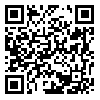Volume 20, Issue 56 (3-2020)
jgs 2020, 20(56): 329-348 |
Back to browse issues page
Download citation:
BibTeX | RIS | EndNote | Medlars | ProCite | Reference Manager | RefWorks
Send citation to:



BibTeX | RIS | EndNote | Medlars | ProCite | Reference Manager | RefWorks
Send citation to:
motamedi M, gharavi M. (2020). Assessing the Model of Resilience of Cities with Fuzzy Dematel Approach, Case study: Gorgan and Shirvan cities. jgs. 20(56), 329-348. doi:10.29252/jgs.20.56.329
URL: http://jgs.khu.ac.ir/article-1-3453-en.html
URL: http://jgs.khu.ac.ir/article-1-3453-en.html
1- Assistant Professor Islamic Azad University of Shirvan, Islamic Azad University of Shirvan , motamedi45@gmail.com
2- PhD student in Geography and Urban Planning, University of Tabriz, Tabriz, Iran., tabriz
2- PhD student in Geography and Urban Planning, University of Tabriz, Tabriz, Iran., tabriz
Abstract: (8067 Views)
Cities are dramatically turning into complex social, economic, and environmental systems. Each urban system is vulnerable when it can not adapt to its changing conditions and critical situations. Therefore, in recent decades, natural disaster response approaches have introduced a new concept of urban resilience to prepare for disaster as much as possible. Is. Despite the recent attention and the abundant use of the concept of resilience in different areas of theoretical and practical limitations of this concept, this study aims to explain the causal pattern of resilience of cities. The present research is based on the descriptive-causal methodology. The statistical sample of the study was compiled by 35 experts and specialists in urban planning. Fuzzy Dumbled Fan was used to achieve the research goal. The findings of this study showed that based on the values of D-R, among the four metrics of urban resilience, the physical criterion with the value (0.943) was the most effective measure of resilience in the city. Also, based on the D + R values, the physical criterion with the value of (896/2) was identified as the most important resiliency criterion in the city.
Keywords: Resilience, physical resilience, social resilience, institutional resilience, economic resilience
Type of Study: Research |
Subject:
Geography and Urban Planning
Send email to the article author
| Rights and permissions | |
 |
This work is licensed under a Creative Commons Attribution-NonCommercial 4.0 International License. |

This work is licensed under a Creative Commons — Attribution-NonCommercial 4.0 International (CC BY-NC 4.0)






